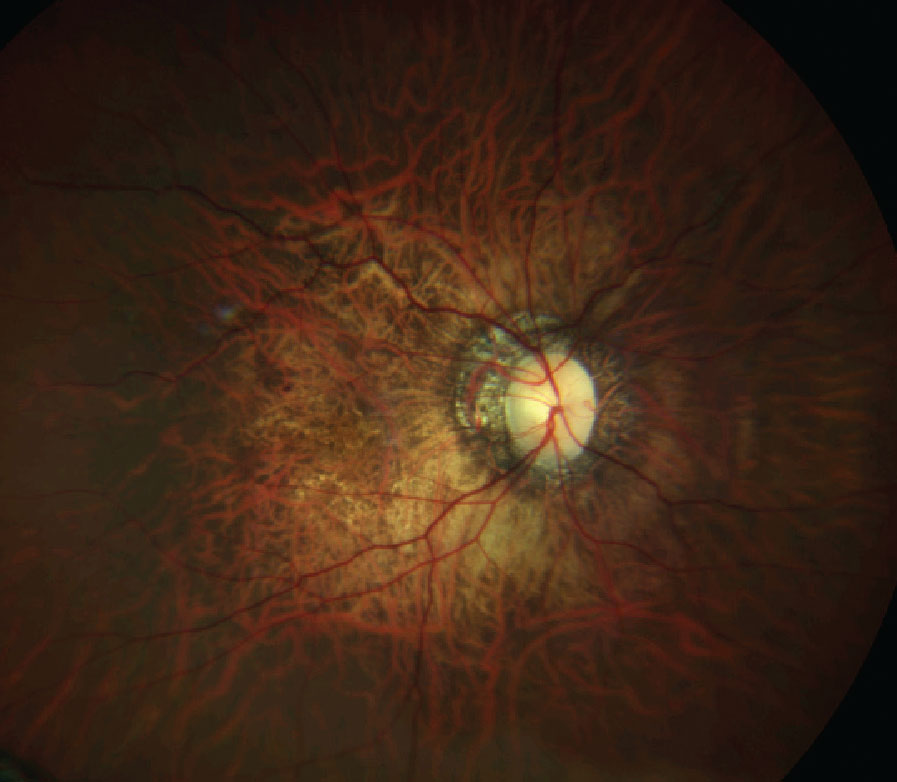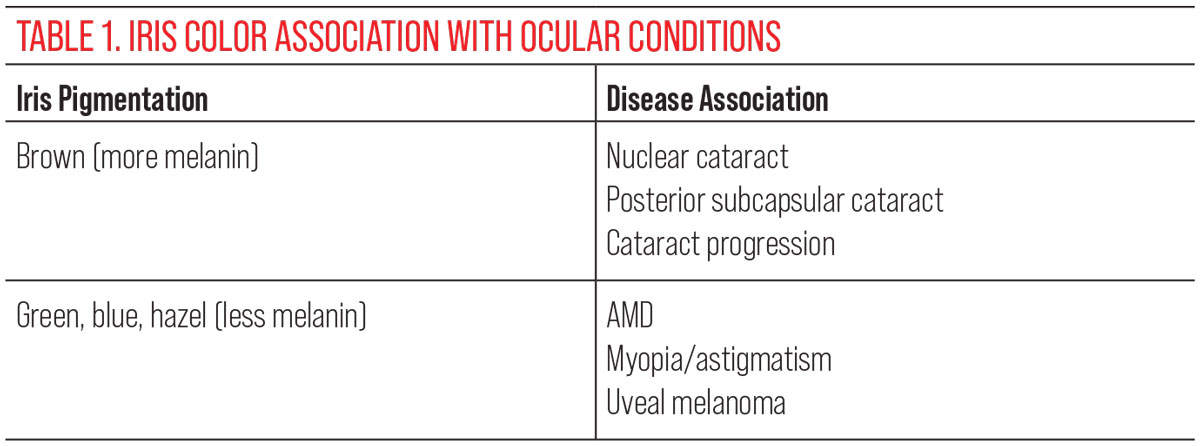 |
Eye color is a noticeable trait to anyone, but the impact it has for the eyecare provider is novel. While one may notice and appreciate variability in eye color and how it affects physical appearance, to the trained practitioner it may also serve as a harbinger of disease. The roles of both the structure and pigment of the iris have been well-studied features in many ocular disease processes. As such, it is important to take this into consideration when examining the iris, paying close attention to intricacies that may coincide with potentially harmful conditions.
Iris Pigment
A key component of color is the presence and function of melanocytes. These cells are present in the anterior border layer of the iris stroma.1 A unique property of melanocytes is their ability to produce melanin in melanosomes. This function is generally influenced by the structural proteins of melanosomes, the enzymes responsible for synthesis of melanin and the proteins required for transportation and distribution of melanin. Melanocyte development and function is an integral part of many features and processes throughout the entire body, not just the eye. However, any disruptions to these functions can produce either hyper- or hypopigmentation, which is often a result of pathological factors.2
Normally, iris color starts out lighter during infancy as pigment develops. While it can darken initially, it is thought to be fully developed by then. Following the conclusion of infancy, additional pigment development is not normally observed. However, some studies do suggest that lightening or loss of iris color can arise with increased age due to changes in melanosome granule morphology.1
 |
|
An example of degenerative myopia, which correlates more with light-colored irises. Click image to enlarge. |
Iris color is determined by a combination of genetic components and ethnicity. However, there are studies suggesting influence from environmental factors as well. Similar to the protective mechanism in skin, people residing in regions with more sunlight may have increased melanin production and darker irises in order to prevent damage to the retina.3 Along the same vein, the degree of pigment in the iris is relevant to its protective function, which explains why color is indicative of the development of some ocular diseases.
Link to Diseases
The leading cause of blindness worldwide is cataracts. While the disease’s development is multifactorial, iris color has been studied in association with age-related cases. In an epidemiologic study of white patients over age 49, those with darker brown-colored irises were found to have an increased incidence of both nuclear and posterior subcapsular cataracts. Further studies elucidated that there was also a higher degree of nuclear cataract acceleration over time.1 Contrasting data in smaller studies have been documented that instead showed that lighter brown-, blue- or green-colored irises correlated more with cataract development.3
Given these conclusions, there are few hypotheses that would explain the role of iris color in cataracts and also affirm the dual genetic and environmental mechanism. One theory is explained by the function of melanin, in that it absorbs photon energy. Subsequently, in eyes with higher melanin content, heat transfer may occur from the iris to the nearby lens, resulting in more rapid radiation-associated damage and resultant acceleration of cataracts.1,3
Another well-documented association between iris color and ocular disease is in age-related macular degeneration (AMD). Studies suggest that blue- or lighter-colored irises are a risk factor for the development of AMD. Again, this can be explained by the function of melanin. The amount of melanin in the iris is directly proportional to the amount of light that is absorbed by the tissue, which is a protective mechanism to prevent oxidative damage from reaching the retina and contributing to AMD.1
 |
| Click image to enlarge. |
While not solidified, there have been hypotheses regarding a link between refractive error and iris color. Myopia has been related to decreased use of sunglasses, which would suggest that dark-colored irises would be more protective against sunlight and, in turn, myopic refractive errors.1 Increased levels of both myopia and astigmatism were observed in animal models studying light- vs. dark-colored irises and refractive errors.3
Another clear association occurs between ocular pigmentation and the incidence of uveal melanomas. These formations are dangerous, sight-threatening tumors that primarily arise in the choroid and, to a lesser degree, the ciliary body and iris. Regardless of the location, the role of iris color in the development of melanoma is well established. Several studies have agreed that the lighter the iris color, particularly green and hazel, the higher the risk of uveal melanoma. The type and amount of melanin are crucial in preventing harmful light from penetrating the eye and causing toxic damage.4
Takeaways
The iris carries out many functions and possesses many distinctive properties. It lies adjacent to the ciliary body and in close proximity to the cornea and lens, and it contains muscles that affect pupil constriction and dilation. In some way or another, it is implicated in countless ocular disease processes. Examining another unique feature, iris color, which is readily observable to any person, can offer unique insight in determining a patient’s risk of developing certain diseases.
Dr. Labib graduated from Pennsylvania College of Optometry, where she now works as an associate professor. She completed her residency in primary care/ocular disease and is a fellow of the American Academy of Optometry and a diplomate in the Comprehensive Eye Care section. She has no financial interests to disclose.
1. Sun HP, Lin Y, Pan CW. Iris color and associated pathological ocular complications: a review of epidemiologic studies. Int J Ophthalmol. 2014;7(5):872-8. 2. Yamaguchi Y, Hearing VJ. Melanocytes and their diseases. Cold Spring Harb Perspect Med. 2014;4(5):a017046. 3. Hashemi H, Pakzad R, Yekta A, et al. Distribution of iris color and its association with ocular diseases in a rural population of Iran. J Curr Ophthalmol. 2018;31(3):312-18. 4. Houtzagers LE, Wierenga APA, Ruys AAM, et al. Iris color and the risk of developing uveal melanoma. Int J Mol Sci. 2020;21(19):7172. |

